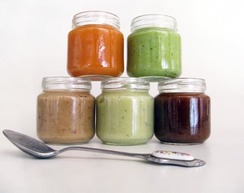 When it comes time to introduce solids to your little one, it can be confusing! There is so much information out there, and it's hard to know where to start, or when to start! So here are some of the basics! When to start: Though some practitioners may recommend beginning little ones on foods around 4 mos, I would recommend pushing off until as close to 6 mos as possible. Babies' digestive tracts are still developing but are almost fully matured around 6 mos. By delaying food intro until then, can help reduce the risk of developing food sensitivities. However, it's also important to follow babies lead. We introduced solids at 5.5 mos after many cues from Lily that she was ready, my favourite, opening her mouth along with our bites! What to start with: This is probably the most confusing part of food intro! And there is lots of info.....
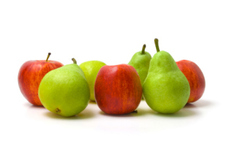
How to Start: When baby seems ready pick a day and plan it out.
Disclaimer: Naturopathic Doctors strive to provide individualized health care. The information contained in these topics is not intended nor implied to be a substitute for professional medical advice, it is provided for educational purposes only. This information shouldn’t take the place of seeing an ND for individualized health recommendations.
0 Comments
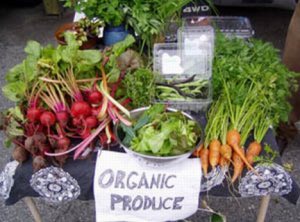 The Shopper's Guide to Pesticides ranks pesticide contamination for 53 popular fruits and vegetables based on an analysis of 51,000 tests for pesticides on these foods, conducted from 2000 to 2009 by the USDA and the federal FDA. Nearly all the studies on which the guide is based tested produce after it had been rinsed or peeled. Contamination was measured in 6 different ways: % of samples tested with detectable pesticides; % of samples with two or more pesticides; Average number of pesticides found on a single sample; Average amount of all pesticides found; Maximum number of pesticides found on a single sample; Total number of pesticides found on the commodity. The fruits and vegetables were then ranked from most pesticides to least. According to EWG’s calculations, by choosing 5 servings of fruits and vegetables from the Clean 15 rather than the Dirty Dozen, you can lower the volume of pesticide you consume daily by 92%!!! For More info visit www.ewg.org/foodnews/ 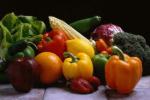 The Dirty Dozen
 The Clean Fifteen
Taken from Spring 2012 Newsletter, to download your own copy of the newsletter, under Resources! Disclaimer: Naturopathic Doctors strive to provide individualized health care. The information contained in these topics is not intended nor implied to be a substitute for professional medical advice, it is provided for educational purposes only. This information shouldn’t take the place of seeing an ND for individualized health recommendations. 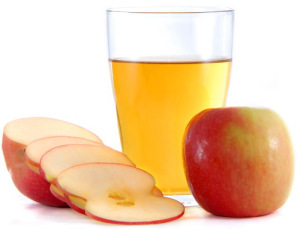 Trying to walk the aisles of a grocery store without seeing products covered with health claims is pretty much impossible anymore. From "low fat" to "source of fiber" to the heart healthy check. Marketing is good. Very good. Unfortunately, many of these claims are only half true. One of my biggest issues is the heart check symbol. A quick look at the Heart and Stroke website shows a HUGE list of foods that have received this health symbol. Checking their nutrient requirements in which to receive the symbol looks extensive but let's take a closer look. The first food listed is fruit juice. The requirements: No added Sugar, a Source of Vitamin C (50%) OR Vitamin A (25%) OR folate (25%) OR fiber (2g). Sounds good, right? But let's put this in perspective, a quick look at one of the products that has received this symbol shows that in 1 cup of this juice, you are getting 160 calories, 39 grams of sugar (!!!!!), NO fiber, NO protein, NO fat. You are essentially drinking a glass of sugar. There is more sugar in this one glass of juice than in a Snickers candy bar! In comparison a medium apple has only 71 calories, 19 grams of carbs (including 3.3 grams of fiber), and a whole lot more nutrients. In general, I don't recommend drinking juice. At all. Eat fruit, drink water. This is a perfect example of a half truth. It's true that this product doesn't contain unhealthy fats. But does that make it a healthy choice? Absolutely not. Another great example is the appearance of every product containing olive oil these days. Olive oil is high in Omega-9 fats and has been shown to benefit heart health. In fact, 2 tbsp/day of raw olive oil has shown benefit in cardiovascular health! Many products have now added olive oil and slap a health check on their products. The problem is, the amount of olive oil in a lot of these products is only a very small percentage. For example, popular margarines only contain 8%. Out of the entire product. The rest is canola oil which hasn't shown the same health benefits. Not to mention the artificial flavour and colours added. Again, yes this product has some heart healthy oil in it, but is it a healthy product overall, no. Some easy health points to remember: 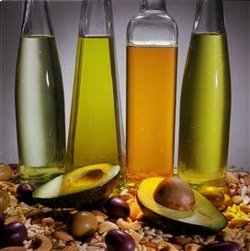
Disclaimer: Naturopathic Doctors strive to provide individualized health care. The information contained in these topics is not intended nor implied to be a substitute for professional medical advice, it is provided for educational purposes only. This information shouldn’t take the place of seeing an ND for individualized health recommendations. 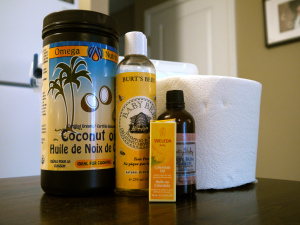 There is nothing better for a parent than a happy rash free baby bum. Baby wipes are a necessary evil. There are many wipes on the market claiming to be natural or organic with a hefty price tag. However, even these tend to contain chemicals that are known skin irritants. The only way to ensure that what you are using is safe and natural is to make it yourself (this is the same rule that is recommended when it comes to cooking!). I started out using Natural Sensitive Baby Wipes but have since switched to homemade wipes and i. love. them. Not only are they exceptionally simple to make, they will save you a couple dollars to boot! What you need:
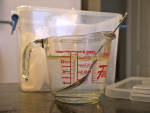 A couple notes: If you choose to use coconut oil, you'll need to use warm water so that the oil melts since it's in a solid form at room temperature. I also like to add a couple drops of Calendula Oil to the mix to help soothe any sensitive skin, Wedela has a great one! This batch of wipes I also added a bit of Baby Bum Remedy by Pretty Cosmetics (an amazing holistic skin care line). Also, I have been using Paper towels from Costco, which are extra large so I use a bit extra of everything to make sure all the towels are moist. This recipe is super versatile too and can be used as wet naps or even make up remover towlettes! Disclaimer: Naturopathic Doctors strive to provide individualized health care. The information contained in these topics is not intended nor implied to be a substitute for professional medical advice, it is provided for educational purposes only. This information shouldn’t take the place of seeing an ND for individualized health recommendations.
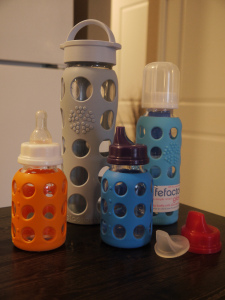 When it came time to pick out bottles, I knew I wanted to stay away from plastic, BPA-free or not. Personally, I love glass. We now only have glass containers so why not glass bottles. After a bit of research I found Life Factory. They make bottles, baby ones and even adult water ones. And they come with fun colourful silicone sleeves to help prevent breakage, should they be dropped (and if you are skeptical, trust me it does work!). The nipples that come with the bottles are plastic free also, they use silicone instead. The bottles are easily heated, sterilized, super convenient (and super cute) and because they're glass, they don't wear out. I even have the adult water bottle, I received as a bday gift (thanks Mal). Annnnnd my favourite part about them was just discovered a week ago....they make a sippy cup attachment (that little pink cap in the pic)! So, the bottles you used with your tiny baby can keep being used with your bigger baby! The sippy cup attachment also has a silicone insert (that white "mini sippy attachment") to help control the water flow. Overall, these bottles have worked wonderfully!! Disclaimer: Naturopathic Doctors strive to provide individualized health care. The information contained in these topics is not intended nor implied to be a substitute for professional medical advice, it is provided for educational purposes only. This information shouldn’t take the place of seeing an ND for individualized health recommendations. 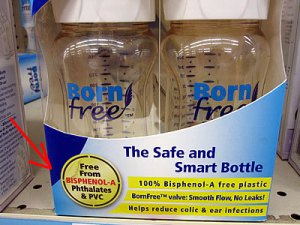 You can't walk through a store these days without seeing at least a few items with that "BPA-Free" label plastered all over the packaging. But does that really mean the plastic used is safe? Healthy? Or even better? BPA is a chemical used to make that clear hard plastic you may actually be carrying your lunch in right now. We also know that this chemical can leach out of plastic into our food and eventually into our bodies. BPA is an endocrine disruptor, meaning it can mimic hormones in our body causing a variety of problems. Specifically, BPA is an estrogenically active compound and has been linked to birth defects, cancers and other health problems. Infants and children are especially vulnerable since their little bodies are less able to detoxify it from their systems. Exposure can even occur while in the womb since BPA can cross the placental and affect development. So, I buy BPA-free, no problem, right? Ever wonder what other kinds of chemicals being used to make plastic could be leaching out of even those BPA-free bottles and containers? Well, so did some researchers, and a study was conducted and published in July 2011 in the Environmental Health Perspectives. It took over 400 everyday products that were BPA-free and tested them for other estrogenic chemicals that could still be leaching out under normal stresses (heating, microwave, dishwasher, sunlight exposure, etc.). What they found: "Almost all commercially available plastic products we sampled—independent of the type of resin, product, or retail source—leached chemicals having reliably detectable EA (estrogenic activity), including those advertised as BPA free. In some cases, BPA-free products released chemicals having more EA than did BPA-containing products." When it comes to baby bottles, they found that at least one part of each baby bottle always had an estrogenic chemical that leached out. And the more stress it under went, the more it leached....how many times do baby bottles get heated, even in a week? 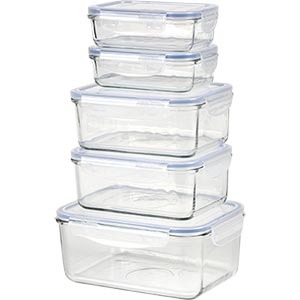 So, what to do? Switch to glass! There are many available products on the market at super reasonable prices. Over the last couple years, I have phased out all the plastic from our kitchen and replaced it with glass containers (ours of choice, Glasslock, available at Costco!). And when it came to baby bottles, we went with glass as well, we chose Life Factory (check out baby favies for more info). A good plastic free water bottle is a must, since it is refilled constantly, try a stainless steel bottle such as those from Kleen Kanteen or my new fave from Life Factory as well. The best part is, these glass or stainless steel products virtually never wear out and will last a life time. And you can rest assured there are no unwanted chemicals taking up residence in your meal. The reality is that in this day and age, it's pretty much impossible to avoid plastics everywhere, but making an effort to use an alternative where you can, can make a huge impact on your health! Disclaimer: Naturopathic Doctors strive to provide individualized health care. The information contained in these topics is not intended nor implied to be a substitute for professional medical advice, it is provided for educational purposes only. This information shouldn’t take the place of seeing an ND for individualized health recommendations. |
AuthorWrite something about yourself. No need to be fancy, just an overview. Archives
August 2016
Categories
All
|


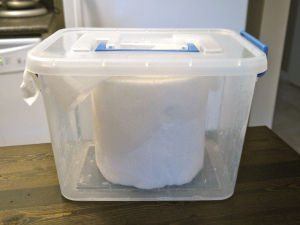
 RSS Feed
RSS Feed
